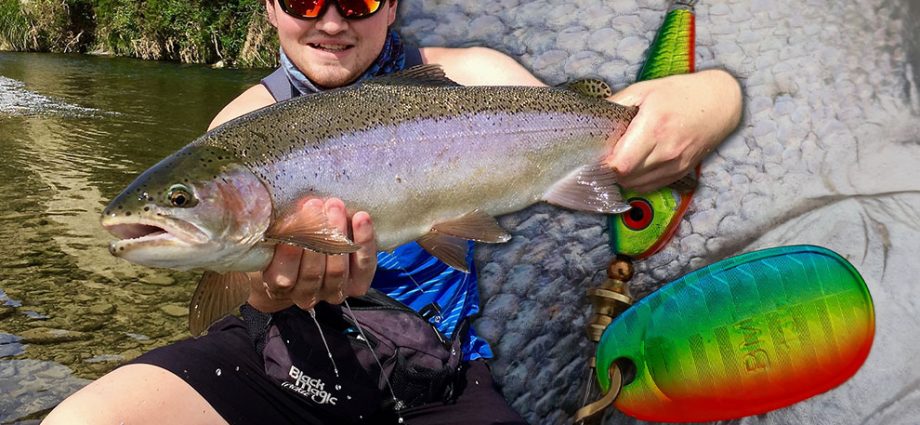Contents
Fishing for rainbow trout
Rainbow trout is acclimatized in many countries of the world. They are native to the rivers of North America. In the Russian Far East lives under the name mykizha. In addition to rivers, this fish is bred in ponds. The fish may have color differences, but acquired the name from the characteristic iridescent stripe on the body. The size and weight of the fish varies. In wild forms, the weight can reach 6 kg. There are intensive ways to grow trout in pools. It is the most popular fish in fish farms, after carp. Often these fish are settled together in pond farms. The main condition for the successful existence of trout in ponds: their flow and temperature 14-180C. The fish is of great commercial importance; due to its high palatability, it is grown in large quantities, including for recreational fishing.
Fishing methods for rainbow trout
Before going on a trout fishing trip and when choosing a fishing method, it is worth considering the location and type of the reservoir. You can fish for trout with both natural and artificial lures. For fishing use spinning, fly fishing, float, bottom gear. In addition, there are a large number of combined snap-ins that are used in an original way.
Spinning rainbow trout
A lot of specialized baits and rods have been invented for catching rainbow trout. The main requirement is lightness and sensitivity. Trout is excellently caught with dead fish rigs, but now, in some waters, this may be prohibited. When using ultra-light rods, when fishing with spinners and wobblers, for example, on small rivers, fishing can be very exciting, and in terms of emotions it is similar to light fly fishing. Before a trip to a paid reservoir, it is worth clarifying the permitted baits, sizes and types of hooks. A ban on tees or barbed hooks is possible.
Fly fishing for rainbow trout
The choice of gear for fly fishing is very diverse. As described earlier, it is worth clarifying the size of the fish and the fishing conditions in the reservoir. The use of various baits and feeding features suggests the possibility of using gear up to class 7-8, including the use of sinking cords. Fishing for this fish is becoming more and more popular using switch rods. Trout fishing baits are very diverse. These can be nymphs and flies on hooks No. 18-20, but in other cases – streamers 5-7 cm. Many very popular, classic fly lures were invented for catching this fish.
Fishing for rainbow trout with other gear
In fish-breeding reservoirs, trout are fed with various specialized feeds. Fish adapt to such a diet. This is the basis for fishing on bottom gear, including feeders. Specialized mixtures are used as bait, and for baits, depending on the reservoir, shrimp meat, worm or maggot, as well as special pastes and granules, are suitable. On flowing reservoirs, trout is also caught on bottom gear. In addition, where the fish are accustomed to natural baits, float rigs are used very successfully, both of a deaf type and with a running rig. Such gear, for fishing with various wires, can be combined with artificial lures, such as octopuses or spinner petals. On freezing reservoirs, they organize fishing for winter gear. The fish responds well to spinners, twisters, balancers, cicadas, as well as to jigs and float gear. For beginner anglers, it will be more interesting to use gear with natural baits.
Baits
Shrimp is the most common natural bait on “payers” offered to beginner fishermen. Among experienced anglers, pastes are very popular. Fishing stores have a large selection of them, there are special ones, but sometimes the fish reacts to non-characteristic aromas. Some make their own pasta. Most often, the aromas of fish, shrimp, and squid are used to attract trout. But there are reservoirs where fish is caught on canned corn.
Places of fishing and habitat
In fish-breeding reservoirs, first of all, it is worth paying attention to the feeding points of fish, as well as the exits of underground springs and spillways. On large lakes, fish can accumulate at the edges, water obstacles and aquatic vegetation. The fish actively feeds on flying insects, by bursts of fattening trout, you can determine its location. On the rivers, feeding fish can be found near the rapids and at the points of convergence of the streams. Any changes in the flow of the river, snags, stones, may be the location of the rainbow trout. Including overhanging trees.
Spawning
Spawning of the rainbow trout, like its Far Eastern relative mykizhi, takes place in autumn. In the reservoirs where this fish lives, a catch ban is established. In fish farms, fish reproduces artificially, already grown individuals get into ponds and lakes. On flowing reservoirs, where this fish is introduced artificially, stocking is also carried out, as a rule, every year.










